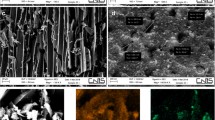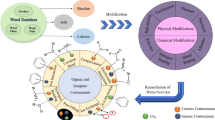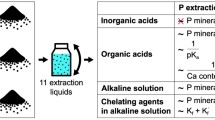Abstract
The present study conducted lead sorption experiments using wood ash to elucidate its capacity and mechanisms of lead removal, to evaluate the recovery of lead removed by wood ash and the reuse of wood ash residue left after lead recovery. The maximum lead removal capacity of wood ash was 3.08 mmol g−1, which was higher than previously reported values. An X-ray diffraction analysis showed that the lead phase removed by wood ash was mainly hydrocerussite probably resulting from the sequential reactions of wood ash with lead ions, dissolution of carbonate ions from wood ash, precipitation of cerussite reacting with lead ions and then alteration to hydrocerussite from cerussite. In addition to the precipitation of hydrocerussite, lead sorption by the acid-insoluble matter in wood ash was also evident. The percentage of lead removed by wood ash in pH 2 solution was very low at 17 %, whereas that at pH 6 was 99 %. Almost all lead removed by wood ash was easily recovered using 0.1 M HNO3, and the residue remaining after lead recovery was able to remove lead repeatedly at rates of 13–22 mg g−1.





Similar content being viewed by others
References
Nozuyama Y (2013) The biomass industrialization strategy and current food waste situation (in Japanese). Mater Cycles Waste Manag Res 24:4–13
Ljung A, Nordin A (1997) Theoretical feasibility for ecological biomass ans recirculation: chemical equilibrium behavior of nutrient elements and heavy metals during combustion. Environ Sci Technol 31:2499–2503
Steenari BM, Karlsson LG, Lindqvist O (1999) Evaluation of the leaching characteristics of wood ash and the influence of ash agglomeration. Biomass Bioenergy 16:119–136
Mahmood S, Finlay RD, Fransson AM, Wallander H (2003) Effects of hardened wood ash on microbial activity plant growth and nutrient uptake by ectomycorrhizal spruce seedlings. FEMS Microbiol Ecol 43:121–131
Etiegni L, Campbell AG, Mahler RL (1991) Evaluation of wood ash disposal on agricultural land I: potential as a soil additive and liming agent. Commun Soil Sci Plant Anal 22:243–256
Demeyer A, Nkana JCV, Verloo MG (2001) Characteristics of wood ash and influence on soil properties and nutrient uptake: an overview. Bioresour Technol 77:287–295
Campbell AG (1990) Recycling and disposing of wood ash. Tappi J 73:141–146
Demirbas A (2004) Adsorption of lead and cadmium ions in aqueous solutions onto modified lignin from alkali glycerol delignication. J Hazard Mater B109:221–226
Fiol N, Villaescusa I, Martínez M, Miralles N, Poch J, Serarols J (2006) Sorption of Pb(II), Ni(II), Cu(II) and Cd(II) from aqueous solution by olive stone waste. Sep Purif Technol 50:132–140
Pehlivan E, Yanik BH, Ahmetli G, Pehlivan M (2008) Equilibrium isotherm studies for the uptake of cadmium and lead ions onto sugar beet pulp. Bioresour Technol 99:3520–3527
Feng Q, Lin Q, Gong F, Sugita S, Shoya M (2004) Adsorption of lead and mercury by rice husk ash. J Colloid Interf Sci 278:1–8
Lister SK, Line MA (2001) Potential utilisation of sewage sludge and paper mill waste for biosorption of metals from polluted waterways. Bioresour Technol 79:35–39
Bouzid J, Elouear Z, Ksibi M, Feki M, Montiel A (2008) A study on removal characteristics of copper from aqueous solution by sewage sludge and pomace ashes. J Hazard Mater 152:838–845
Elouear Z, Bouzid J, Boujelben N (2009) Removal of nickel and cadmium from aqueous solutions by sewage sludge ash: study in single and binary systems. Environ Technol 30:561–570
Machida M, Yamazaki R, Aikawa M, Tatsumoto H (2005) Role of minerals in carbonaceous adsorbents for removal of Pb(II) ions from aqueous solution. Sep Purif Technol 46:88–94
Katoh M, Matsuoka H, Hattori T, Sato T (2013) Lead sorption from aqueous solution using apatite and residue ash recovered from sewage sludge ash (in Japanese). J JSCE Ser G (Environ Res) 69:III_281–III_290
Malakootian M, Almasi A, Hossaini H (2008) Pb and Co removal from paint industries effluent using wood ash. Int J Environ Sci Tech 5:217–222
Chirenje T, Ma LQ, Lu L (2006) Retention of Cd, Cu, Pb and Zn by wood ash, lime and fume dust. Water Air Soil Pollut 171:301–314
Pitman RM (2006) Wood ash use in foresty: a review of the environmental impacts. Forestry 79:563–588
Misra MK, Ragland KW, Baker AJ (1993) Wood ash composition as a function of furnace temperature. Biomass Bioenergy 4:103–116
Someshwar AV (1996) Wood and combination wood-fired boiler ash characterization. J Environ Qual 25:962–972
Hakkila P (1989) Utilization of residual forest biomass. Springer, Berlin
Cao X, Ma LQ, Rhue DR, Appel CS (2004) Mechanisms of lead, copper, and zinc retention by phosphate rock. Environ Pollut 131:435–444
Dong L, Zhu Z, Qiu Y, Zhao J (2010) Removal of lead from aqueous solution by hydroxyapatite/magnetite composite adsorbent. Chem Eng J 165:827–834
Katoh M, Gotoh S, Sato T (2012) Estimation of lead sorption based on phosphorus dissolution from apatite (in Japanese). J JSCE Ser G (Environ Res) 68:III_435–III_442
Ahmaruzzaman M (2011) Industrial wastes as low-cost potential adsorbents for the treatment of wastewater laden with heavy metals. Adv Colloid Interf 166:36–59
Chiron M, Guilet R, Deydier E (2003) Adsorption of Cu(II) and Pb(II) onto a grafted silica: isotherms and kinetics models. Water Res 37:3079–3086
Acknowledgments
The ICP-AES instrument used for the chemical analyses in this study was provided by the Division of Instrumental Analysis at Gifu University. The authors are grateful to Prof. Y. Ohya (Gifu University) for permitting use of the XRD and acknowledge to the Nanki Constructional Cooperative Association for partially financial supports of this work.
Author information
Authors and Affiliations
Corresponding author
Rights and permissions
About this article
Cite this article
Katoh, M., Shiramizu, M. & Sato, T. Repeatable use of wood ash to remove lead from contaminated water. J Mater Cycles Waste Manag 17, 590–597 (2015). https://doi.org/10.1007/s10163-014-0286-2
Received:
Accepted:
Published:
Issue Date:
DOI: https://doi.org/10.1007/s10163-014-0286-2




